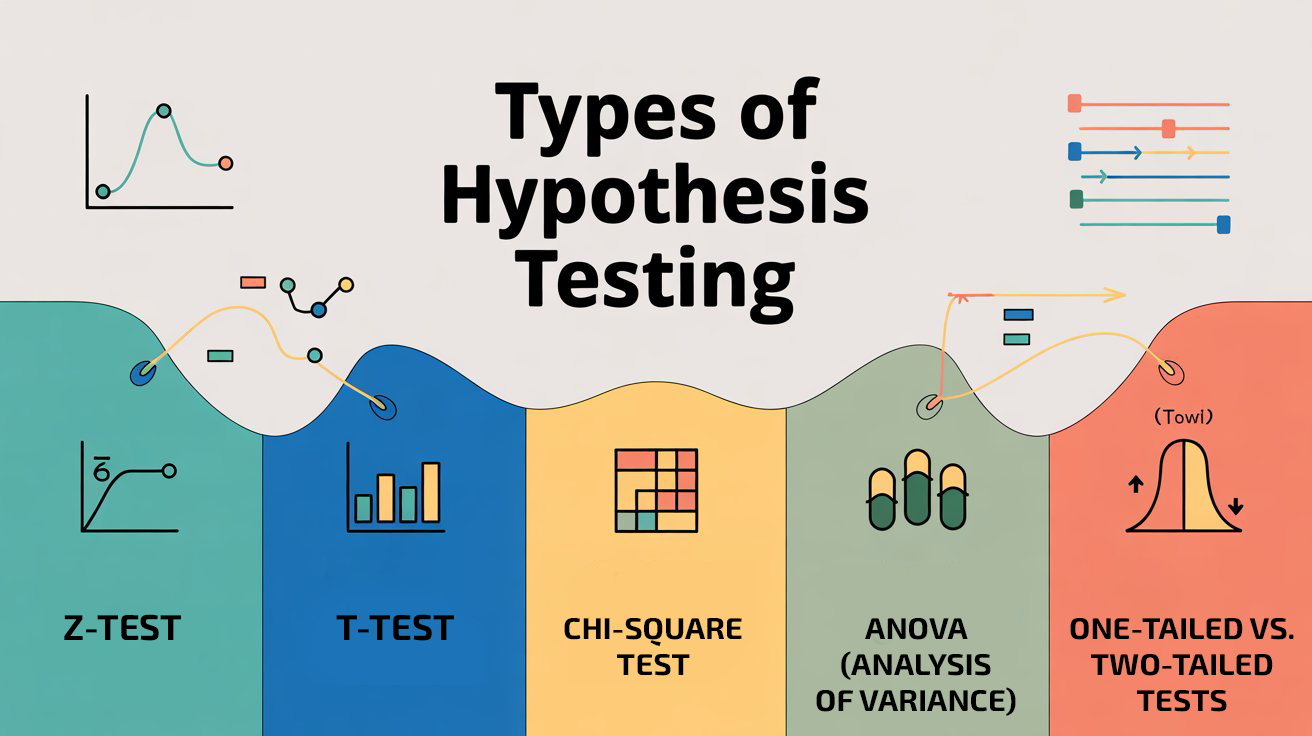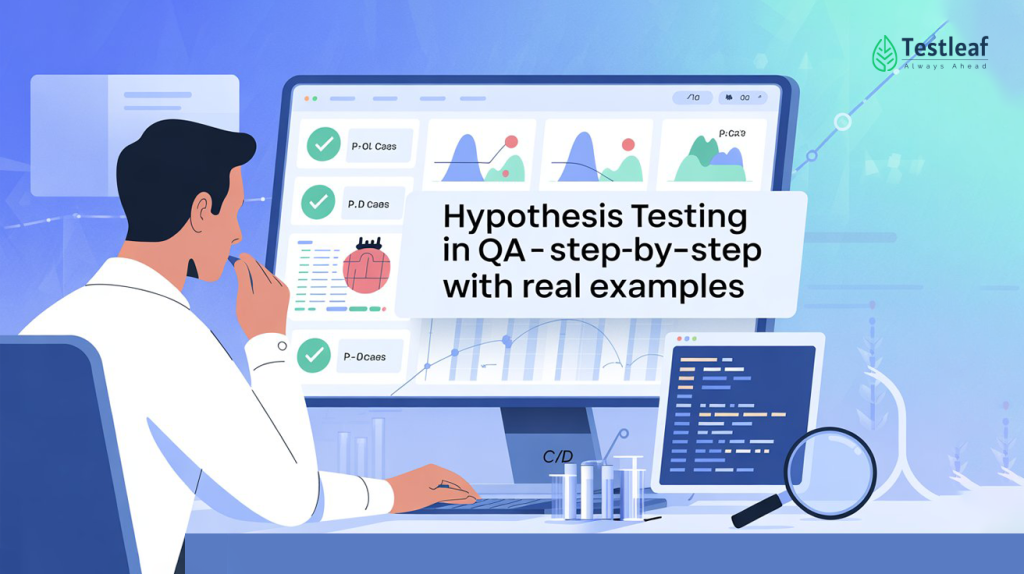Introduction
In the world of Quality Assurance (QA), decision-making often relies on evidence rather than assumptions. Whether it’s validating a new feature, analyzing defect trends, or confirming a performance improvement, QA engineers must rely on statistical thinking. That’s where hypothesis testing comes in — a structured approach to validate assumptions with data.
This method, widely used in research and analytics, is now becoming essential for QA professionals who want to make smarter, data-backed testing decisions. In this blog, we’ll explore what is hypothesis testing, the types of hypothesis testing, and real-world examples showing how it can elevate your QA strategy.
What Is Hypothesis Testing?
Hypothesis testing is a statistical method used to make decisions or inferences about a population based on sample data. In simple terms, it helps QA teams decide whether a particular assumption about a product or process is true or false, using actual test results.
Imagine you’ve optimized your application to improve its loading speed. You assume it’s now faster than before — but how do you prove it? By collecting load time data before and after optimization, and applying hypothesis testing, you can statistically confirm whether the performance improvement is significant or just random variation.
At its core, hypothesis testing involves two statements:
· Null Hypothesis (H₀): The assumption that there is no change or difference. Example: “There is no difference in page load time before and after optimization.”
· Alternative Hypothesis (H₁): The assumption that there is a change or difference. Example: “The page load time is faster after optimization.”
Once you have both, you collect data, perform a test, and use statistical metrics like p-value to decide whether to reject or accept the null hypothesis.
Recommended for You: Epam interview questions
Types of Hypothesis Testing
There are several types of hypothesis testing methods that QA professionals can apply depending on the scenario. Let’s look at the most common ones:
1. Z-Test
Used when you have a large sample size (typically >30) and know the population variance. Example: Comparing the average response time of 100 API calls before and after an update to see if the performance truly improved.
2. T-Test
Used when the sample size is small or when population variance is unknown. Example: A QA engineer compares memory usage of two app versions on 10 test devices.
3. Chi-Square Test
Used for categorical data — for instance, comparing the number of passed and failed test cases across modules. Example: Testing if defect occurrence differs between web and mobile platforms.
4. ANOVA (Analysis of Variance)
Used to compare means of more than two groups. Example: Measuring user login times across multiple regions to see if geography impacts performance.
5. One-Tailed vs. Two-Tailed Tests
· One-tailed: Checks for a change in one direction (e.g., “Is the new version faster?”).
· Two-tailed: Checks for any change in either direction (e.g., “Is there a difference in speed, faster or slower?”).
Each type helps QA teams validate assumptions under different testing conditions — ensuring decisions are guided by facts, not intuition.

Step-by-Step Process for Hypothesis Testing in QA
Let’s break down how hypothesis testing fits into a QA workflow:
Step 1: Define the Problem
Identify what you want to test. For example: “Does implementing caching reduce the average response time?”
Step 2: Formulate Hypotheses
· H₀: Caching has no effect on response time.
· H₁: Caching reduces response time.
Step 3: Collect Data
Gather performance data — response times before and after caching from multiple runs or environments.
Step 4: Choose the Test Type
Based on data size and type, select the right statistical test (e.g., T-Test for small samples, Z-Test for large samples).
Step 5: Set the Significance Level (α)
Commonly set at 0.05 (5%). It means you’re willing to accept a 5% chance of error in your decision.

Step 6: Calculate the Test Statistic
Using statistical tools or even Python libraries (like SciPy), compute the test statistic and p-value.
Step 7: Make the Decision
· If p-value ≤ α, reject H₀ (there is a significant difference).
· If p-value > α, fail to reject H₀ (no significant difference).
Step 8: Draw the Conclusion
If caching truly reduced response time, you’ll have statistical evidence to support it — not just a gut feeling.
Other Helpful Articles: api testing interview questions
Real Examples of Hypothesis Testing in QA
Example 1: Performance Optimization
A QA team suspects that moving from HTTP to HTTP/2 reduces API latency.
· H₀: Average API latency is the same for HTTP and HTTP/2.
· H₁: Average API latency is lower for HTTP/2. After collecting latency data and applying a T-test, they find a p-value of 0.02. Since it’s less than 0.05, they conclude that HTTP/2 indeed improved performance.
Example 2: UI Change Impact
A tester wants to know if a new button placement affects user click rates.
· H₀: The new placement doesn’t change click rates.
· H₁: The new placement increases click rates. After A/B testing 500 users, results show a significant increase — proving the UI tweak improved engagement.
Example 3: Defect Prediction
By applying hypothesis testing on past defect data, QA can validate if certain modules consistently show higher defect density, helping prioritize regression testing more effectively.
Other Useful Guides: automation testing interview questions
Why QA Professionals Should Learn Hypothesis Testing
Hypothesis testing brings data-driven precision to software quality. Instead of assuming what’s wrong or right, QA teams can validate every change statistically. This ensures better quality metrics, smarter releases, and improved collaboration between QA and development.
If you’re a tester looking to master such analytical approaches, enrolling in a software testing course in Chennai can help. You’ll learn not only automation tools like Selenium and Playwright but also statistical QA concepts like hypothesis testing, ensuring you stay ahead in 2026’s competitive testing landscape.
Conclusion
Hypothesis testing empowers QA engineers to move from intuition to insight. By learning to validate results with real data, you build credibility, accuracy, and trust in your testing process. Whether you’re optimizing performance, measuring UI impact, or validating new features — this method ensures every decision stands on solid evidence.
In today’s data-driven world, QA isn’t just about finding bugs — it’s about proving improvements. Start learning analytical QA practices through a reputed software testing course in Chennai and make your next testing report more powerful than ever.
FAQs
1. What is hypothesis testing in QA?
Hypothesis testing helps QA teams use data to determine whether a change, improvement, or difference in the application is real or just random variation.
2. When should QA engineers use hypothesis testing?
Use it when validating performance optimizations, A/B UI experiments, defect trends, or comparing application versions.
3. Which hypothesis testing method is best for performance testing?
T-Tests are commonly used for comparing performance metrics when sample sets are small; Z-Tests help when sample size is large.
4. Do QA engineers need to know statistics?
Not deeply. Understanding basic hypothesis testing makes QA analysis more precise and credible in decision-making.
5. Can automation engineers apply hypothesis testing?
Yes — especially in evaluating performance results, success rates, and experimental UI metrics in CI/CD pipelines.
We Also Provide Training In:
- Advanced Selenium Training
- Playwright Training
- Gen AI Training
- AWS Training
- REST API Training
- Full Stack Training
- Appium Training
- DevOps Training
- JMeter Performance Training
Author’s Bio:

Content Writer at Testleaf, specializing in SEO-driven content for test automation, software development, and cybersecurity. I turn complex technical topics into clear, engaging stories that educate, inspire, and drive digital transformation.
Ezhirkadhir Raja
Content Writer – Testleaf








